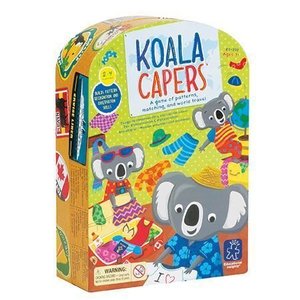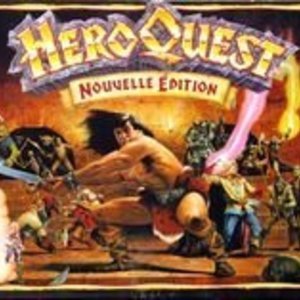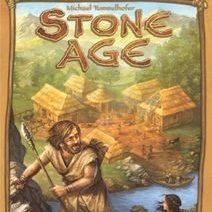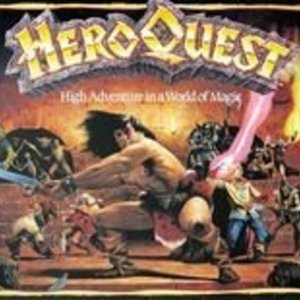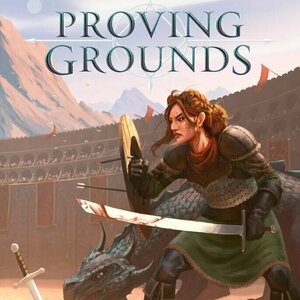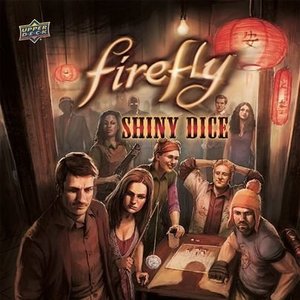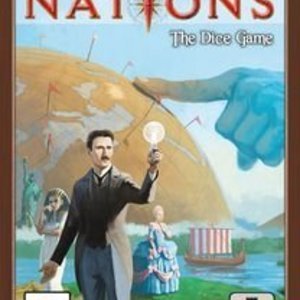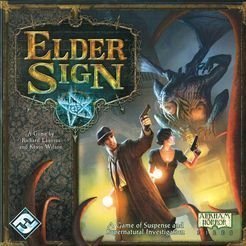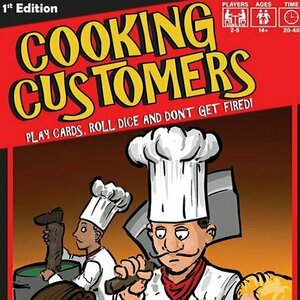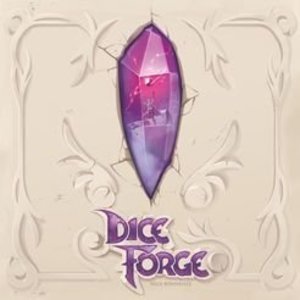Search
Search results
Purple Phoenix Games (2266 KP) rated Koala Capers in Tabletop Games
Jun 18, 2019 (Updated Mar 10, 2020)
The Kids Table series from Purple Phoenix Games seeks to lightly explore games that are focused toward children and families. We will do our best to give some good insight, but not bog your down with the millions of rules…
Koala Capers is a silly dice and pattern recognition game that kids way younger than 3 years old can play; I have played it with my 2 year old – for like 5 minutes.
The game comes in a non-conforming, but fun, box that we used as a dice tray. You roll the dice, try to find an outfit card that matches what you rolled and place the new outfit on your koala card (the one shown below is currently naked). If you roll underpants, you make your koala naked and try again. If you roll a star it’s wild and you can choose any outfit you like.
This is an easy winner. It has very few components, very few rules, and has lots of silliness in it – especially when you roll the undies. Kids love when adults lose. My boy really likes it, and it has been his first choice from his small collection lately.
Give it a try if you want to introduce your children or family into dice rolling, customizing characters, light set collection, learning patterns, and also possibly having to reconstruct after rolling poorly. We like it a lot, for what it is.
Koala Capers is a silly dice and pattern recognition game that kids way younger than 3 years old can play; I have played it with my 2 year old – for like 5 minutes.
The game comes in a non-conforming, but fun, box that we used as a dice tray. You roll the dice, try to find an outfit card that matches what you rolled and place the new outfit on your koala card (the one shown below is currently naked). If you roll underpants, you make your koala naked and try again. If you roll a star it’s wild and you can choose any outfit you like.
This is an easy winner. It has very few components, very few rules, and has lots of silliness in it – especially when you roll the undies. Kids love when adults lose. My boy really likes it, and it has been his first choice from his small collection lately.
Give it a try if you want to introduce your children or family into dice rolling, customizing characters, light set collection, learning patterns, and also possibly having to reconstruct after rolling poorly. We like it a lot, for what it is.
Ross (3284 KP) rated HeroQuest Advanced Quest in Tabletop Games
Apr 4, 2018
The advanced quest was a step beyond the "newb-friendly" Hero Quest. Dice rolling was made more complex, and the quests became more arduous. This was a step too far and possibly put me off a career in D&D for life, after the gentle, easy to follow rules of the original. The added rules and complexity took away from the enjoyment for me, but then I was only about 11 at the time...
Entertainment Editor (1988 KP) rated Stone Age in Tabletop Games
Mar 7, 2018 (Updated Mar 7, 2018)
Dice are most of the time anathema to Euro gamers. The numbered cubes are seen as the center of luck-driven games. Almost all of us have a tale to tell of knocking on the door of Irkutsk with a giant army only to be fended off by a few lucky rolls.
Reviewer: Farmerlenny
Read the full review here: http://islaythedragon.com/game-reviews/a-rolling-stone-gathers-no-moss-a-review-of-stone-age/
Reviewer: Farmerlenny
Read the full review here: http://islaythedragon.com/game-reviews/a-rolling-stone-gathers-no-moss-a-review-of-stone-age/
Ross (3284 KP) rated HeroQuest in Tabletop Games
Apr 4, 2018
The original and best. HeroQuest is such a gentle, yet thrilling entry into the world of RPGs, where simple dice throwing, teamwork and spell casting can allow a team to pit their strength against pre-designed quests. A vast array of furniture, special tiles, doors and evil creatures are waiting to be put on the board when you enter the room, but be prepared to have to search for traps, secret doors and pitfalls or you won't get far. One player acts as Dungeon Master, the rest pick their characters (barbarian, dwarf, wizard or elf), each with their own skills and abilities.
Dice rolling was as simple as skulls or shields - beat the enemy's roll (allowing for handicaps) to defeat them and move on.
Dice rolling was as simple as skulls or shields - beat the enemy's roll (allowing for handicaps) to defeat them and move on.
Purple Phoenix Games (2266 KP) rated Proving Grounds in Tabletop Games
Aug 23, 2021
Maia Strongheart sees the eight opponents surrounding her and knows exactly how to handle each one. She makes a dash for #4, a simpleton Warrior in Training, and whoosh – misses. “Huh, that’s never happened to me before,” she thinks. Performing a daring backflip whilst targeting the Clan Elder in the #6 position with a well-placed finishing blow and whoosh – her armor seems to part like the Red Sea as the Clan Elder finds its weakness and delivers a wound to our heroine. “WHO IS PLAYING ME?” Maia wonders. It’s me. Travis. The worst player of Proving Grounds. Poor Maia.
Proving Grounds is a solo fighting dice game with real-time phases. Players will win by defeating eight opponents in battle and will lose (often, in my case) if the heroine suffers too many wounds. The game is played over several rounds, and Renegade has provided an app to act as a timer during the rolling dice phase. Obviously I am terrible at the game, but how does it play and do I feel like continuing to suffer subsequent losses?
To setup a basic game, place the Encounter Board in the middle of the table. Shuffle the enemy cards (with swords & board backs) and deal one per slot around the Encounter Board. These are the first set of enemies Maia will be fighting. Place Battle Markers (silver ninja stars that track wounds inflicted to enemies) in the outlined spaces of the enemy cards. Place Maia’s health token (a heart) on the tracker and one each of the green, yellow, and blue dice on the health area in the space with a rainbow surround. Fill the exhaustion track with one white die per space (on the right side of the Encounter Board), and take the rest of the dice into hand to use as the dice pool. For this review I also used the Dragonling Die module.
As mentioned, Proving Grounds is played solo over a series of rounds. Each round consists of three phases: Roll Dice, Resolve Attacks, and Recover. The first phase of the game, Roll Dice, is also the most chaotic. During this phase the app timer (or your phone or sand timer or sun dial) will allow 60 seconds to roll the dice and arrive at a final result. The interesting aspect of this mechanic at play here is that only sets of dice may be rerolled, not singles. So players may only roll that set of four 3s and not the solitary 1 sitting there all alone. This causes some brain freeze because many games utilize this in reverse, where only singles may be rerolled. Factor that into a 60 second frenzy to get the greatest results and brains will smoke.
Once the timer is up or players are satisfied with the rolled results, they move to the next phase: Resolve Attacks. Each number rolled on the dice correspond to the enemy’s position around the Encounter Board. So that solitary 1 that was rolled earlier is assigned to the enemy in position #1. Here’s the kick in the rear though: any single dice assigned to an enemy will result in a wound dealt to Maia, and would require the player to sacrifice one of the dice to the exhaustion track! Should an enemy require three or more dice but only two are assigned, or if zero dice are assigned, nothing happens to Maia nor the enemy. But those dang single dice will come back to haunt the player. A lot, if they play like I do. Some enemies will require at least one of the dice to be the blue/green/yellow die in order to be successful while others are just straight number of dice. Calculating everything that is needed during the Roll Dice phase is something that I have yet to master.
After attacks are resolved, players enter the Recover phase. During this phase players will gather all assigned dice from the round as well as any dice on the lowest spot of the exhaustion track to be used for the next round. Any enemies that were defeated have left an empty slot on the Encounter Board, so a new enemy will now fill that void. Play continues in this fashion of three phases per round until either eight enemies have been defeated or Maia suffers too many wounds to continue.
Components. I am fascinated by how few components are needed to put a game like this together. Yes, the Encounter Board is mostly unnecessary, but a great way to organize the game and keep everything spacially relevant for those of us that need that. The cards are fine quality and the game has great art. The dice are very cool, but I am unsure how the colors pop for our colorblind gamer friends. While the game doesn’t necessarily refer to the damage markers as “ninja stars” I cannot get over the fact that they are ninja stars. They are certainly out of place in a game like this where I encountered zero ninjas in my plays. Everything else, though, is great and it comes in a nice-sized box: a little smaller than my Century: Golem Edition box.
It was Kane Klenko’s birthday recently, so I wished him a happy birthday on social media and informed him that I was celebrating by playing Proving Grounds. His response was absolutely perfect: “Good luck!” Well, Kane, I never have good luck with this one! It is certainly a combination of poor dice rolling, poor decision making whilst rolling dice, and just dumb luck (emphasis on dumb). I love playing this game but it is infuriating that I have yet to beat it! Even with just the first Dragonling Die module! Gahhhhhh!!!
However, Proving Grounds is an excellent dice game that breaks out of the Yahtzee clone mold and into something fresh and exciting. The twist of only being able to reroll sets instead of singles makes for interesting decisions when you really need to defeat enemy #5 but just cannot roll ANY 5s to save your life (in the game). I just want to beat it once with the Dragonling Die so I can start adding in other modules (oh yes, there are several other modules to add). When games force me to WANT to play them more and more, even for the sheer hope of victory, I consider that a mark of distinction and a sign of a great game.
So if you are like me and enjoy the pain of defeat over and over again then I invite you to try Proving Grounds. It will not be easy. But if you happen to beat it, especially on your first try, please let me know. I need all the cheat codes I can get here. It will stay in my collection probably forever because I just need to overcome it, and then once I figure it out completely, I will just need to wallop it over and over to teach it a lesson. Enjoy Proving Grounds everyone!
Proving Grounds is a solo fighting dice game with real-time phases. Players will win by defeating eight opponents in battle and will lose (often, in my case) if the heroine suffers too many wounds. The game is played over several rounds, and Renegade has provided an app to act as a timer during the rolling dice phase. Obviously I am terrible at the game, but how does it play and do I feel like continuing to suffer subsequent losses?
To setup a basic game, place the Encounter Board in the middle of the table. Shuffle the enemy cards (with swords & board backs) and deal one per slot around the Encounter Board. These are the first set of enemies Maia will be fighting. Place Battle Markers (silver ninja stars that track wounds inflicted to enemies) in the outlined spaces of the enemy cards. Place Maia’s health token (a heart) on the tracker and one each of the green, yellow, and blue dice on the health area in the space with a rainbow surround. Fill the exhaustion track with one white die per space (on the right side of the Encounter Board), and take the rest of the dice into hand to use as the dice pool. For this review I also used the Dragonling Die module.
As mentioned, Proving Grounds is played solo over a series of rounds. Each round consists of three phases: Roll Dice, Resolve Attacks, and Recover. The first phase of the game, Roll Dice, is also the most chaotic. During this phase the app timer (or your phone or sand timer or sun dial) will allow 60 seconds to roll the dice and arrive at a final result. The interesting aspect of this mechanic at play here is that only sets of dice may be rerolled, not singles. So players may only roll that set of four 3s and not the solitary 1 sitting there all alone. This causes some brain freeze because many games utilize this in reverse, where only singles may be rerolled. Factor that into a 60 second frenzy to get the greatest results and brains will smoke.
Once the timer is up or players are satisfied with the rolled results, they move to the next phase: Resolve Attacks. Each number rolled on the dice correspond to the enemy’s position around the Encounter Board. So that solitary 1 that was rolled earlier is assigned to the enemy in position #1. Here’s the kick in the rear though: any single dice assigned to an enemy will result in a wound dealt to Maia, and would require the player to sacrifice one of the dice to the exhaustion track! Should an enemy require three or more dice but only two are assigned, or if zero dice are assigned, nothing happens to Maia nor the enemy. But those dang single dice will come back to haunt the player. A lot, if they play like I do. Some enemies will require at least one of the dice to be the blue/green/yellow die in order to be successful while others are just straight number of dice. Calculating everything that is needed during the Roll Dice phase is something that I have yet to master.
After attacks are resolved, players enter the Recover phase. During this phase players will gather all assigned dice from the round as well as any dice on the lowest spot of the exhaustion track to be used for the next round. Any enemies that were defeated have left an empty slot on the Encounter Board, so a new enemy will now fill that void. Play continues in this fashion of three phases per round until either eight enemies have been defeated or Maia suffers too many wounds to continue.
Components. I am fascinated by how few components are needed to put a game like this together. Yes, the Encounter Board is mostly unnecessary, but a great way to organize the game and keep everything spacially relevant for those of us that need that. The cards are fine quality and the game has great art. The dice are very cool, but I am unsure how the colors pop for our colorblind gamer friends. While the game doesn’t necessarily refer to the damage markers as “ninja stars” I cannot get over the fact that they are ninja stars. They are certainly out of place in a game like this where I encountered zero ninjas in my plays. Everything else, though, is great and it comes in a nice-sized box: a little smaller than my Century: Golem Edition box.
It was Kane Klenko’s birthday recently, so I wished him a happy birthday on social media and informed him that I was celebrating by playing Proving Grounds. His response was absolutely perfect: “Good luck!” Well, Kane, I never have good luck with this one! It is certainly a combination of poor dice rolling, poor decision making whilst rolling dice, and just dumb luck (emphasis on dumb). I love playing this game but it is infuriating that I have yet to beat it! Even with just the first Dragonling Die module! Gahhhhhh!!!
However, Proving Grounds is an excellent dice game that breaks out of the Yahtzee clone mold and into something fresh and exciting. The twist of only being able to reroll sets instead of singles makes for interesting decisions when you really need to defeat enemy #5 but just cannot roll ANY 5s to save your life (in the game). I just want to beat it once with the Dragonling Die so I can start adding in other modules (oh yes, there are several other modules to add). When games force me to WANT to play them more and more, even for the sheer hope of victory, I consider that a mark of distinction and a sign of a great game.
So if you are like me and enjoy the pain of defeat over and over again then I invite you to try Proving Grounds. It will not be easy. But if you happen to beat it, especially on your first try, please let me know. I need all the cheat codes I can get here. It will stay in my collection probably forever because I just need to overcome it, and then once I figure it out completely, I will just need to wallop it over and over to teach it a lesson. Enjoy Proving Grounds everyone!
Purple Phoenix Games (2266 KP) rated Firefly: Shiny Dice in Tabletop Games
Jun 12, 2019
One of the best parts of the board gaming experience is finding a fun group of people with whom to play! Sometimes, though, coordinating a game night is easier said than done. We all must occasionally forego the group experience and face the world as the Lonely Only. But fear not! The world of solo-play is a vast and exciting realm! What follows is a chronicle of my journey into the solo-playing world – notes on gameplay, mechanics, rules, difficulty, and overall experience with solo variations of commonly multiplayer games! I hope this will provide some insight as you continue to grow your collection, or explore your already owned games!
I really like Firefly. So when Travis told me he had Firefly: Shiny Dice, and was looking to get rid of it, I jumped on the chance to get my hands on something Firefly! I’d never played the game and had never even heard of it either. Having played it now, though, I can see why Travis wanted to off-load it on someone else.
In Firefly: Shiny Dice, over the course of three rounds, players are rolling dice to assemble a crew, complete missions, and defeat bad guys. All of the main characters of the show are represented by different die faces, each with a special power. Use those powers to help defeat bad guys and earn VPs on your turn each round! The player at the end of the game with the most points is the winner. Firefly: Shiny Dice is played the same way, regardless of player count – in solo play, you are still trying to amass the most points possible over three rounds.
At it’s core, Firefly: Shiny Dice is a dice-rolling game. And that’s where the simplicity ends. This game is bogged down an ambiguously confusing rulebook, complicated turn steps, and just way too much text overall. When I first got this game, I was psyched to play. I sat down, opened up the rulebook, read through it at least 3 times, and then put the game away. I was so confused by what I had read, I couldn’t even bring myself to try it at first. There is a lot of ambiguity in the rulebook that caused a lot of confusion and frustration for me. For example, the brown dice are Outlaw characters and the white dice are Passenger characters, but the rulebook and player aids use “Crew Dice” most of the time – so are they all Crew Dice, or just the Outlaws since, in the show, those are the characters who actually are the crew on Serenity? Are Passengers considered Crew? The same ambiguity goes for Mission Cards – if you draw one that you cannot complete, is it just discarded? Then what’s the point of the Mission Card? How about if you draw one and don’t want to complete it? Are you required to complete it if you can? Or can you choose to ignore it to negate the Mission Keyword? I felt like after I read the rulebook, I actually had more questions than before I started.
Regarding turn order, there is just way too much going on for me. There are 4 steps each turn, and some steps have several ‘phases.’ First you roll your dice, and then depending on what you rolled maybe you can re-roll some, and then you have to check to see if you got any bonuses/penalties after your re-roll, but then you stop and draw a Mission Card and possibly resolve it (?), and now you go and deal 1 damage to a foe but only if the current Mission says ‘Shiny,’ and then the foe dice resolve their effects, and now you can use your dice and character powers to fight the foes, and then depending on how many dice you have left/the Mission Keyword from your card this turn, you can decide to push your luck and take another turn immediately or just end your turn now. Whew. There are just way too many unnecessary steps, in my opinion. All you should need to do is to roll/re-roll your dice, resolve foe effects, and fight the foes. The Missions and die bonuses/penalties feel extraneous to me, and result in clunky gameplay.
In theory, this should be a cool game. In reality, it’s just frustrating. To me it feels like every single small idea made it into the end-game, but they were not executed well enough to justify including them. This game is way too wordy and ambiguous to make sense, and even though I keep the rulebook on hand every time I play, I feel like it doesn’t really help me at all. I think a more pared down/edited version of this game could be a hit.
As a fan of Firefly, I want to like this game. I really do. But I don’t. I think it is too complicated and far too confusing for what it is supposed to be, which is a relatively light dice-rolling game. Firefly: Shiny Dice is not on my short-list of games to play, nor is it on my long-list (is that a thing?). It’s kind of just in my collection at this point, though I don’t know if it’ll stay here for long.
https://purplephoenixgames.wordpress.com/2019/01/28/solo-chronicles-firefly-shiny-dice/
I really like Firefly. So when Travis told me he had Firefly: Shiny Dice, and was looking to get rid of it, I jumped on the chance to get my hands on something Firefly! I’d never played the game and had never even heard of it either. Having played it now, though, I can see why Travis wanted to off-load it on someone else.
In Firefly: Shiny Dice, over the course of three rounds, players are rolling dice to assemble a crew, complete missions, and defeat bad guys. All of the main characters of the show are represented by different die faces, each with a special power. Use those powers to help defeat bad guys and earn VPs on your turn each round! The player at the end of the game with the most points is the winner. Firefly: Shiny Dice is played the same way, regardless of player count – in solo play, you are still trying to amass the most points possible over three rounds.
At it’s core, Firefly: Shiny Dice is a dice-rolling game. And that’s where the simplicity ends. This game is bogged down an ambiguously confusing rulebook, complicated turn steps, and just way too much text overall. When I first got this game, I was psyched to play. I sat down, opened up the rulebook, read through it at least 3 times, and then put the game away. I was so confused by what I had read, I couldn’t even bring myself to try it at first. There is a lot of ambiguity in the rulebook that caused a lot of confusion and frustration for me. For example, the brown dice are Outlaw characters and the white dice are Passenger characters, but the rulebook and player aids use “Crew Dice” most of the time – so are they all Crew Dice, or just the Outlaws since, in the show, those are the characters who actually are the crew on Serenity? Are Passengers considered Crew? The same ambiguity goes for Mission Cards – if you draw one that you cannot complete, is it just discarded? Then what’s the point of the Mission Card? How about if you draw one and don’t want to complete it? Are you required to complete it if you can? Or can you choose to ignore it to negate the Mission Keyword? I felt like after I read the rulebook, I actually had more questions than before I started.
Regarding turn order, there is just way too much going on for me. There are 4 steps each turn, and some steps have several ‘phases.’ First you roll your dice, and then depending on what you rolled maybe you can re-roll some, and then you have to check to see if you got any bonuses/penalties after your re-roll, but then you stop and draw a Mission Card and possibly resolve it (?), and now you go and deal 1 damage to a foe but only if the current Mission says ‘Shiny,’ and then the foe dice resolve their effects, and now you can use your dice and character powers to fight the foes, and then depending on how many dice you have left/the Mission Keyword from your card this turn, you can decide to push your luck and take another turn immediately or just end your turn now. Whew. There are just way too many unnecessary steps, in my opinion. All you should need to do is to roll/re-roll your dice, resolve foe effects, and fight the foes. The Missions and die bonuses/penalties feel extraneous to me, and result in clunky gameplay.
In theory, this should be a cool game. In reality, it’s just frustrating. To me it feels like every single small idea made it into the end-game, but they were not executed well enough to justify including them. This game is way too wordy and ambiguous to make sense, and even though I keep the rulebook on hand every time I play, I feel like it doesn’t really help me at all. I think a more pared down/edited version of this game could be a hit.
As a fan of Firefly, I want to like this game. I really do. But I don’t. I think it is too complicated and far too confusing for what it is supposed to be, which is a relatively light dice-rolling game. Firefly: Shiny Dice is not on my short-list of games to play, nor is it on my long-list (is that a thing?). It’s kind of just in my collection at this point, though I don’t know if it’ll stay here for long.
https://purplephoenixgames.wordpress.com/2019/01/28/solo-chronicles-firefly-shiny-dice/
Purple Phoenix Games (2266 KP) rated Nations: The Dice Game in Tabletop Games
Aug 16, 2019 (Updated Jul 17, 2021)
If you have been around board games over the past several years you will notice trends here and there. Some games came out with smaller, easier to digest, versions of themselves as card games, or roll-and-writes, or in this case: dice games. The goal is to get the same kind of feeling and experience as playing the older sibling in a much smaller and time-friendly spin-off. I have played Nations (the original big game) before, but does Nations: The Dice Game give a similar feel?
Nations: The Dice Game (can I please just call it Nations for this review as we know I am not talking about the original? Thanks.) is a civilization building, upgrade tile drafting, dice game for one to four players. Players will be upgrading their civilizations over four game rounds to compete for Books and VPs. The player with the most VP at the end of the game is the winner.
Disclaimer: The photos shown here is for a solo game, as I took them during my learning game using the solo rules. Normally the purple d4 is not used in multiplayer games. -T
To setup, each player will choose a starter civilization mat, receive five white dice, a gold chit, and a re-roll chit. Player order will be determined by cards and each player will receive their player order card which doubles as a reference card (great idea). The Progress Board will be set on the table and populated with randomized Age I Progress tiles according to the rule book. The Score Board will also be placed on the table to track Books, Events, and final VPs. The game begins with each player rolling their five dice.
Nations (TDG) is played over four ages with multiple rounds per age. At the beginning of each age old tiles will be removed from the Progress Board and new ones for the current age added. Also an Event tile will be drawn and placed on the Score Board to signify goals for Famine and War at the end of the age. On a player’s turn they will take one action from the following: Re-Roll (any or all unused dice by spending a re-roll chit), Buy tile (from the Progress Board to upgrade player mat spaces and dice), or Build Wonder (tile using Stone dice or chits for VP). When a player has taken as many turns/actions they wish for the age, they turn their player order card to the side to indicate they have passed for the remainder of the age.
Once all players have passed, they will tally their unused dice and any chits showing Books to be recorded on the Book track. Players will score points for Books based on how many opponents they have outscored for Books. Then players will consult the face-up Event tile that was revealed at the beginning of the round. The top portion displays VP earned when players discard unused dice and chits showing Famine leaf icons matching or exceeding what is on the Event tile. Similarly, for War players will consult the Event tile and use the sword icons on unused dice and chits to score any VPs for War. Play continues in this way across all four ages and once the fourth age has been scored the game ends and winner named victorious!
Components. I have mostly good news here. The dice in this dice game are wonderful. They are all easy to read and understand, and feel great when rolling nine or ten of them at once. The chits are fine, the Progress and Event tiles are nice and thick. The player mats, Score Board, and Progress Board are very thin though. I was going to give that a negative remark, but you know, players don’t really handle them during the game so there is no real need for them to be any thicker. The art is similar as in Nations, and while it does not resonate with me, it is fine. I won’t be playing Nations for the art.
All in all the game is fine. It didn’t blow me away or completely replace Nations (the big game) for me. It IS a pretty quick game to play, so there is one definite improvement over the big brother game; 10-15 minutes per player is pretty spot on. I usually do not prefer dice games to the originals (BANG! The Dice Game being the obvious improvement), and this one is really just on par with the big game. While it takes up less space on the shelf, I wouldn’t necessarily recommend it over its sibling. I feel the same way about each game, so my recommendation is get the version you feel would be played more often. Purple Phoenix Games gives Nations: The Dice Game a Montezuma-should-be-in-Age-IV 6 / 12. Give it a shot if you are into dice games, but grab the original if you want something meatier.
Nations: The Dice Game (can I please just call it Nations for this review as we know I am not talking about the original? Thanks.) is a civilization building, upgrade tile drafting, dice game for one to four players. Players will be upgrading their civilizations over four game rounds to compete for Books and VPs. The player with the most VP at the end of the game is the winner.
Disclaimer: The photos shown here is for a solo game, as I took them during my learning game using the solo rules. Normally the purple d4 is not used in multiplayer games. -T
To setup, each player will choose a starter civilization mat, receive five white dice, a gold chit, and a re-roll chit. Player order will be determined by cards and each player will receive their player order card which doubles as a reference card (great idea). The Progress Board will be set on the table and populated with randomized Age I Progress tiles according to the rule book. The Score Board will also be placed on the table to track Books, Events, and final VPs. The game begins with each player rolling their five dice.
Nations (TDG) is played over four ages with multiple rounds per age. At the beginning of each age old tiles will be removed from the Progress Board and new ones for the current age added. Also an Event tile will be drawn and placed on the Score Board to signify goals for Famine and War at the end of the age. On a player’s turn they will take one action from the following: Re-Roll (any or all unused dice by spending a re-roll chit), Buy tile (from the Progress Board to upgrade player mat spaces and dice), or Build Wonder (tile using Stone dice or chits for VP). When a player has taken as many turns/actions they wish for the age, they turn their player order card to the side to indicate they have passed for the remainder of the age.
Once all players have passed, they will tally their unused dice and any chits showing Books to be recorded on the Book track. Players will score points for Books based on how many opponents they have outscored for Books. Then players will consult the face-up Event tile that was revealed at the beginning of the round. The top portion displays VP earned when players discard unused dice and chits showing Famine leaf icons matching or exceeding what is on the Event tile. Similarly, for War players will consult the Event tile and use the sword icons on unused dice and chits to score any VPs for War. Play continues in this way across all four ages and once the fourth age has been scored the game ends and winner named victorious!
Components. I have mostly good news here. The dice in this dice game are wonderful. They are all easy to read and understand, and feel great when rolling nine or ten of them at once. The chits are fine, the Progress and Event tiles are nice and thick. The player mats, Score Board, and Progress Board are very thin though. I was going to give that a negative remark, but you know, players don’t really handle them during the game so there is no real need for them to be any thicker. The art is similar as in Nations, and while it does not resonate with me, it is fine. I won’t be playing Nations for the art.
All in all the game is fine. It didn’t blow me away or completely replace Nations (the big game) for me. It IS a pretty quick game to play, so there is one definite improvement over the big brother game; 10-15 minutes per player is pretty spot on. I usually do not prefer dice games to the originals (BANG! The Dice Game being the obvious improvement), and this one is really just on par with the big game. While it takes up less space on the shelf, I wouldn’t necessarily recommend it over its sibling. I feel the same way about each game, so my recommendation is get the version you feel would be played more often. Purple Phoenix Games gives Nations: The Dice Game a Montezuma-should-be-in-Age-IV 6 / 12. Give it a shot if you are into dice games, but grab the original if you want something meatier.
Purple Phoenix Games (2266 KP) rated Elder Sign in Tabletop Games
Jul 16, 2019 (Updated Aug 21, 2019)
One of the best parts of the board gaming experience is finding a fun group of people with whom to play! Sometimes, though, coordinating a game night is easier said than done. We all must occasionally forego the group experience and face the world as the Lonely Only. But fear not! The world of solo-play is a vast and exciting realm! What follows is a chronicle of my journey into the solo-playing world – notes on gameplay, mechanics, rules, difficulty, and overall experience with solo variations of commonly multiplayer games! I hope this will provide some insight as you continue to grow your collection, or explore your already owned games!
Disclaimer: There are many expansions for Elder Sign. I do not have any of them, nor do I have any gameplay experience with any of them. If and when I do get them added into my base game, I will either amend this review or write a new one! – L
In Elder Sign, players take on the roles of Investigators who must use their supernatural knowledge and keen wit to seal dimensional portals and prevent the Ancient Ones from entering our world and destroying humanity. Just another day at the office, right? Players take turns rolling dice to fight monsters and complete adventures that will reward them with artifacts, health and/or sanity, clues, or even Elder Signs – the symbols necessary for sealing away the Ancient Ones for good. Be careful, though – if you fail to complete an adventure, you will be harshly punished! I’m talking losing health and sanity, accidentally summoning monsters, or even bringing the Ancient One one step closer to our world! As a solo game, Elder Sign plays the same way as it would in a group setting. The only difference is that the solo player cannot use the ‘Assisting’ ability because there are no other players who can offer you aid. Besides that, gameplay remains the same – even a lone Investigator can put their dice to good use to ward off evil!
I enjoy playing Elder Sign as a solo game. Although mostly dominated by dice rolling, there is a fair amount of strategy required for this game. I don’t feel like I’m mindlessly rolling dice – I have to decide which adventures are attainable with my given items, and which rewards benefit me the most in my overall task. There are rewards and consequences to be weighed with every decision, so action must be taken with great thought. Because of the strategic implications, Elder Sign keeps me thoroughly engaged, even when playing solo, and that’s one reason why I keep coming back to it.
On the flip side, one thing that isn’t my favorite about Elder Sign is its reliance on dice rolls to progress in the game. Yeah, I know, it’s a dice game – what did I expect? Sometimes, though, you just can’t roll to save your life (quite literally, in this game) and that can make the game frustrating to play. A series of poor rolls can feel like they completely negate any strategy you’ve enacted and can unravel your entire plan. On a good dice-rolling day for me, I love this game! On a not-so-good dice-rolling day, I find it a little harder to enjoy myself. But hey – if it was totally easy, it wouldn’t be fun, right? One positive of this, I guess, is that I always have to be adjusting my strategy to take the current dice into account. I can’t just pick one strategy and run with it since almost all outcomes are dependent on the luck of the roll! Elder Sign keeps me on my toes, that’s for sure.
I got Elder Sign from Travis as a birthday present last year, and it has been a good addition to my collection. There is enough going on to keep me engaged the entire game, but not so much that I feel overwhelmed. And yeah, maybe I’m not always the greatest dice-roller, but that just makes me adapt my strategy to deal with the current situation. I have read that adding expansions makes the game even more enjoyable, and hopefully one of these days I’ll get to experience that for myself. For the time being, though, I’m content with the base game. If you enjoy Elder Sign, I recommend you try it solo – it doesn’t feel any different to play, and I think you’ll enjoy it just as much as a group game!
Disclaimer: There are many expansions for Elder Sign. I do not have any of them, nor do I have any gameplay experience with any of them. If and when I do get them added into my base game, I will either amend this review or write a new one! – L
In Elder Sign, players take on the roles of Investigators who must use their supernatural knowledge and keen wit to seal dimensional portals and prevent the Ancient Ones from entering our world and destroying humanity. Just another day at the office, right? Players take turns rolling dice to fight monsters and complete adventures that will reward them with artifacts, health and/or sanity, clues, or even Elder Signs – the symbols necessary for sealing away the Ancient Ones for good. Be careful, though – if you fail to complete an adventure, you will be harshly punished! I’m talking losing health and sanity, accidentally summoning monsters, or even bringing the Ancient One one step closer to our world! As a solo game, Elder Sign plays the same way as it would in a group setting. The only difference is that the solo player cannot use the ‘Assisting’ ability because there are no other players who can offer you aid. Besides that, gameplay remains the same – even a lone Investigator can put their dice to good use to ward off evil!
I enjoy playing Elder Sign as a solo game. Although mostly dominated by dice rolling, there is a fair amount of strategy required for this game. I don’t feel like I’m mindlessly rolling dice – I have to decide which adventures are attainable with my given items, and which rewards benefit me the most in my overall task. There are rewards and consequences to be weighed with every decision, so action must be taken with great thought. Because of the strategic implications, Elder Sign keeps me thoroughly engaged, even when playing solo, and that’s one reason why I keep coming back to it.
On the flip side, one thing that isn’t my favorite about Elder Sign is its reliance on dice rolls to progress in the game. Yeah, I know, it’s a dice game – what did I expect? Sometimes, though, you just can’t roll to save your life (quite literally, in this game) and that can make the game frustrating to play. A series of poor rolls can feel like they completely negate any strategy you’ve enacted and can unravel your entire plan. On a good dice-rolling day for me, I love this game! On a not-so-good dice-rolling day, I find it a little harder to enjoy myself. But hey – if it was totally easy, it wouldn’t be fun, right? One positive of this, I guess, is that I always have to be adjusting my strategy to take the current dice into account. I can’t just pick one strategy and run with it since almost all outcomes are dependent on the luck of the roll! Elder Sign keeps me on my toes, that’s for sure.
I got Elder Sign from Travis as a birthday present last year, and it has been a good addition to my collection. There is enough going on to keep me engaged the entire game, but not so much that I feel overwhelmed. And yeah, maybe I’m not always the greatest dice-roller, but that just makes me adapt my strategy to deal with the current situation. I have read that adding expansions makes the game even more enjoyable, and hopefully one of these days I’ll get to experience that for myself. For the time being, though, I’m content with the base game. If you enjoy Elder Sign, I recommend you try it solo – it doesn’t feel any different to play, and I think you’ll enjoy it just as much as a group game!
Purple Phoenix Games (2266 KP) rated Cooking Customers in Tabletop Games
Feb 4, 2020
Raise your hand if you have ever worked in the food industry. Okay, I see a few hands. Now raise your hand if you have ever been so torqued by a customer that you wanted to cook them in a pie. Oh, thanks for your hand Mrs. Lovett. Good to know. Well this game is an experience of getting your money and getting out. Fastest one to do so will win, and if you have to stew a few eyeballs in the process, more power to you.
DISCLAIMER: We were provided a copy of this game for the purposes of this review. This is a retail copy of the game, so what you see in these photos is exactly what would be received in your box. I do not intend to cover every single rule included in the rulebook, but will describe the overall game flow and major rule set so that our readers may get a sense of how the game plays. For more in depth rules, you may purchase a copy online or from your FLGS. -T
Cooking Customers is a card and dice game where the first player to amass $20 in “tips” will be crowned the winner. Players earn tips by serving enough meals to customers at each table. Players can receive meals by rolling them on dice, or by card manipulation. Let me explain.
To setup, place the meals (black discs) in the middle of the table for all to reach. Similarly, place all the dice nearby. These dice have three sides: FIRED, MEAL, and a blank side. Shuffle the mighty deck of cards and deal five to each player, placing the rest of the deck in the middle of the table. Finally, shuffle the Table cards and place somewhere near the other components. Players are now ready to begin!
On a player’s turn, they will first draw the topmost Table card to be placed in front of themselves. This card will show how many meals need to be served to it to be satisfied and earn tips. The Table cards will mostly just sit there in front of players collecting meal discs for the game’s duration. Once a Table card is drawn (and only one Table per player, please) the active player may then play cards from hand. A player may play one or two cards, but only one card may be played to the active player’s tableau, and only one card may be played on an opponent. Should a player not wish to play a card to anyone’s tableau, they must discard a card to the middle of the table. Then the active player will draw back to the hand size of five cards.
Cards played to other players are usually bad, Munchkin-esque cards that halt progression or just cause mayhem for their designs. I will not go into detail on these, as half the fun of this game is the Take-That of these cards. Cards played to a player’s own tableau can be a myriad choices: Cooks, Helpers, Kitchen Supplies, etc. The most important are the Cook cards. A player will need to have a Cook “hired” in front of them in order to participate in the next phase of the game: rolling dice. Players can have Helper cards (sous chefs) and Kitchen Supplies active without a Cook, but the player may not roll dice or serve meals without a Cook. Cooks and Helpers will dictate how many dice are rolled in the next phase of a turn, and rolling more dice is always better.
Once all cards have been played on a player’s turn, they may now roll the dice (though for a game with such a dark theme I say we use the “Roll Them Bones” colloquialism). When the dice are rolled, players are hoping for MEAL to show up on all dice. This is how a meal can be collected and served to the Table cards. However, if at any time all dice read FIRED then the player’s Cook is fired and they may not continue rolling dice. The Cook is discarded and play is forfeited to the next player. #cheflife amirite?
Once a Table card has all the meals it needs to be satisfied, the player may score it by flipping it over to reveal the amount in tips they have earned. Play continues in this fashion until one player has earned $20 in tips. They can then taunt the other players with their superiority.
Components. Cooking Customers is a BUNCH of cards, some painted wooden discs, and some embossed dice. The cards are good quality, the discs are good as well, and the dice are great. All the components are pretty darn good. The art, though gross at times, is really well-done (see what I did there) and kept us laughing throughout our plays.
I do have one qualm about this game: the rulebook. Though only six pages long and with lots of illustrations throughout, I found that reading it made me more confused than it should have. I did take the rulebook’s advice to go to the publisher’s website, goodenoughgames.com, and watch the rules explanation and playthrough. That helped immensely to clear up what the rulebook did to my brain.
All in all, we had a great time playing this one. We all like Munchkin, and though it is NOT Munchkin, Cooking Customers delivers a take-that dice and card game that really is worth checking out. If you are looking for something with a new theme that plays quickly and has some meat on its bones (and there), then we certainly recommend Cooking Customers. Purple Phoenix Games gives this one a hearty (food puns are too easy) 13 / 18. You can purchase a copy at goodenoughgames.com currently. While you’re there please watch the video.
DISCLAIMER: We were provided a copy of this game for the purposes of this review. This is a retail copy of the game, so what you see in these photos is exactly what would be received in your box. I do not intend to cover every single rule included in the rulebook, but will describe the overall game flow and major rule set so that our readers may get a sense of how the game plays. For more in depth rules, you may purchase a copy online or from your FLGS. -T
Cooking Customers is a card and dice game where the first player to amass $20 in “tips” will be crowned the winner. Players earn tips by serving enough meals to customers at each table. Players can receive meals by rolling them on dice, or by card manipulation. Let me explain.
To setup, place the meals (black discs) in the middle of the table for all to reach. Similarly, place all the dice nearby. These dice have three sides: FIRED, MEAL, and a blank side. Shuffle the mighty deck of cards and deal five to each player, placing the rest of the deck in the middle of the table. Finally, shuffle the Table cards and place somewhere near the other components. Players are now ready to begin!
On a player’s turn, they will first draw the topmost Table card to be placed in front of themselves. This card will show how many meals need to be served to it to be satisfied and earn tips. The Table cards will mostly just sit there in front of players collecting meal discs for the game’s duration. Once a Table card is drawn (and only one Table per player, please) the active player may then play cards from hand. A player may play one or two cards, but only one card may be played to the active player’s tableau, and only one card may be played on an opponent. Should a player not wish to play a card to anyone’s tableau, they must discard a card to the middle of the table. Then the active player will draw back to the hand size of five cards.
Cards played to other players are usually bad, Munchkin-esque cards that halt progression or just cause mayhem for their designs. I will not go into detail on these, as half the fun of this game is the Take-That of these cards. Cards played to a player’s own tableau can be a myriad choices: Cooks, Helpers, Kitchen Supplies, etc. The most important are the Cook cards. A player will need to have a Cook “hired” in front of them in order to participate in the next phase of the game: rolling dice. Players can have Helper cards (sous chefs) and Kitchen Supplies active without a Cook, but the player may not roll dice or serve meals without a Cook. Cooks and Helpers will dictate how many dice are rolled in the next phase of a turn, and rolling more dice is always better.
Once all cards have been played on a player’s turn, they may now roll the dice (though for a game with such a dark theme I say we use the “Roll Them Bones” colloquialism). When the dice are rolled, players are hoping for MEAL to show up on all dice. This is how a meal can be collected and served to the Table cards. However, if at any time all dice read FIRED then the player’s Cook is fired and they may not continue rolling dice. The Cook is discarded and play is forfeited to the next player. #cheflife amirite?
Once a Table card has all the meals it needs to be satisfied, the player may score it by flipping it over to reveal the amount in tips they have earned. Play continues in this fashion until one player has earned $20 in tips. They can then taunt the other players with their superiority.
Components. Cooking Customers is a BUNCH of cards, some painted wooden discs, and some embossed dice. The cards are good quality, the discs are good as well, and the dice are great. All the components are pretty darn good. The art, though gross at times, is really well-done (see what I did there) and kept us laughing throughout our plays.
I do have one qualm about this game: the rulebook. Though only six pages long and with lots of illustrations throughout, I found that reading it made me more confused than it should have. I did take the rulebook’s advice to go to the publisher’s website, goodenoughgames.com, and watch the rules explanation and playthrough. That helped immensely to clear up what the rulebook did to my brain.
All in all, we had a great time playing this one. We all like Munchkin, and though it is NOT Munchkin, Cooking Customers delivers a take-that dice and card game that really is worth checking out. If you are looking for something with a new theme that plays quickly and has some meat on its bones (and there), then we certainly recommend Cooking Customers. Purple Phoenix Games gives this one a hearty (food puns are too easy) 13 / 18. You can purchase a copy at goodenoughgames.com currently. While you’re there please watch the video.
Lumos (380 KP) rated Dice Forge in Tabletop Games
Mar 19, 2018
This game is really unique. I enjoy deck builders and dice games and this combines the two. Instead of building a deck of cards, however, you are altering the faces of a pair of dice to accumulate resources and take actions. I like that you gather resources on all players' turns because it allows you to have enough to do on your turn. This is a competitive game, however there is little you can do that will really hinder anther player's game play. There are some "attacks" but they are more little setbacks for the other player rather than total game changers. Overall, I think this is a really fun game. It takes a little playing before you get the hang of how to change the die faces, but it is really pretty easy once you get it together. I also like the fact that it is a fast game. Since all players are rolling during all the turns, you aren't really waiting for your turn, which is nice.
